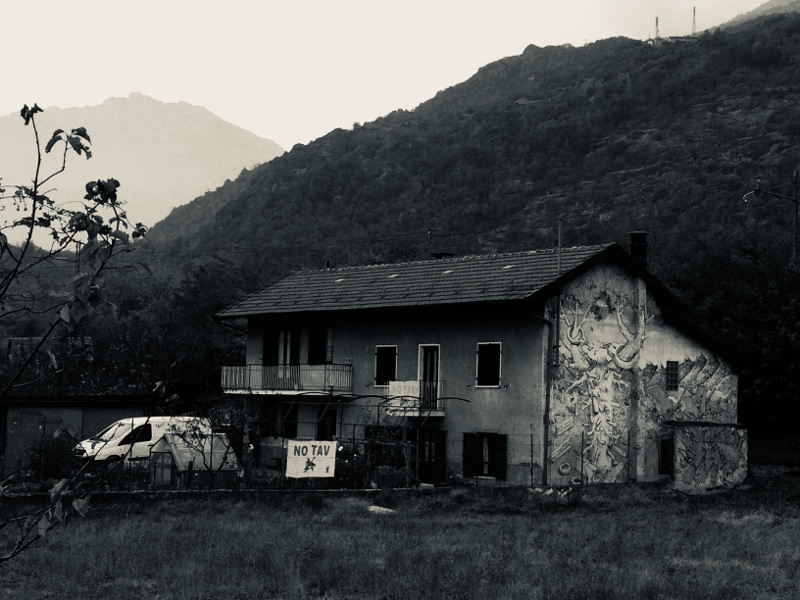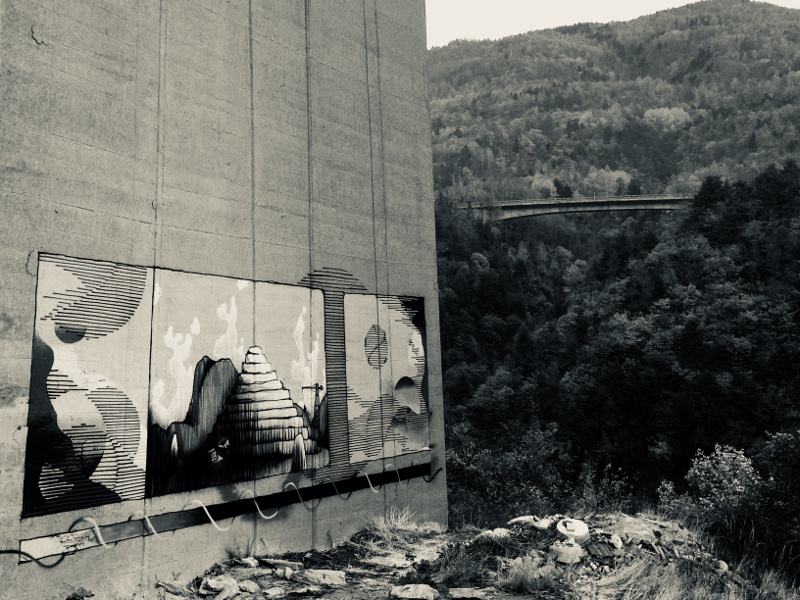Photo: Luca Perino
No TAV: feeding the fire of resistance in northern Italy
- November 16, 2017
Anarchism & Autonomy
The decades-old struggle of the No TAV movement in northern Italy is an inspiration to environmentalist and anti-capitalist movements worldwide.
- Author
When I get to Turin airport, on a warm autumn day, the smell of smoke is overwhelming. The weather forecast on my phone shows me a big bright sun, but I can only see clouds outside. It is only when we enter the highway that I realize that this ocean of greyness has nothing to do with clouds. The Piedmont is in fact on fire, and the flames have engulfed the Susa Valley for close to a week.
The Susa Valley is a beautiful strip of land, located between Italy and France, with the Alps on either side overlooking the valley and acting as a protector. Its inhabitants are known for their stubbornness and attachment to the land. A montagnard mentality. For them, leaving is never an option. Their attachment and closeness to the land reminds me of the Native American communities in the US or the Aboriginal people in Australia, as it is both spiritual, physical and practical. People have been evacuated from their homes, and the rest of the inhabitants of the small villages dotted in the valley now live in the fear that they too, sooner or later, will be told to do the same.
When my local contacts — Mina, an activist, and the lawyers Valentina and Emmanuel — pick me up from the airport, they explain that another type of fire has engulfed the valley for more than twenty-five years: the fire of revolt.
 Being a key route for trade, business and tourism for two of Europe’s powerhouses, the Susa Valley has attracted many mega-infrastructural projects throughout the years, none of them more controversial and virulently opposed than the Turin-Lyon high-speed freight railway line.
Being a key route for trade, business and tourism for two of Europe’s powerhouses, the Susa Valley has attracted many mega-infrastructural projects throughout the years, none of them more controversial and virulently opposed than the Turin-Lyon high-speed freight railway line.
For a quarter of a century, people from all walks of life have fought against this mega-project, a railway line of 270 kilometers with at its core a tunnel of nearly sixty kilometers long, crossing the Alps between Susa Valley and the city of Maurienne in France.
The Italian and French governments together with the European Union, which is funding 40 percent of the 26 billion euro project, laud the railway as something that will benefit both the people and the freight companies, as well as provide hundreds of jobs. The inhabitants of the valley, who were never properly consulted in the first place, say that this new line is not only unnecessary — since the current line has, according to expert surveys and report, room to expand — but will only bring environmental destruction and economic and social disaster to the valley and its people.
It is feared that the drilling will cause the release of asbestos and uranium from the mountains, polluting the valley. Local residents also question the ballooning cost of the project at a time when drastic austerity measures mean that hospitals and core public services are closing or are being privatized — activists in the valley claim that the cost needed to build a single kilometer of track would be enough to build a hospital. On top of this, it has been reported that key beneficiaries of the project will be obscure construction companies with strong links to the mafia. According to a report by Arte, four companies working on the project have been found to have links to the ‘Ndràngheta mafia.
 The people I encounter over two days, essentially people who have lived in the valley for decades or more, are clear about one thing: for them, this is a fight for survival, a fight of nature against capitalism, a fight about the meaning of progress, about the world we want to live in, about people versus corporations and states. Despite the hugely disproportionate balance of power, and despite the hardships that most people here have faced over decades of fighting, none of them are ready to stop.
The people I encounter over two days, essentially people who have lived in the valley for decades or more, are clear about one thing: for them, this is a fight for survival, a fight of nature against capitalism, a fight about the meaning of progress, about the world we want to live in, about people versus corporations and states. Despite the hugely disproportionate balance of power, and despite the hardships that most people here have faced over decades of fighting, none of them are ready to stop.
Over the course of lunch at La Credenza, a typical Italian restaurant located in Bussoleno that sometimes serves as headquarters for No TAV activists and where portraits of Che Guevara and Zapata are lined up against the walls with paintings from demonstrations and flags of solidarity with Notre Dames des Landes in France as well as Palestine, the EZLN in Chiapas and other movements, I meet with Nicoletta Dosio, one of the icons of the struggle.
In 2015, Nicoletta was charged by a Turin tribunal for her actions during a demonstration against the project. A year later, she was put under house arrest after she failed to show up for her daily report to the police station. Nicoletta decided to ignore this order too, and in September 2016 she left her home. A huge solidarity campaign started while Nicoletta went on a very public run. Her act of civil disobedience while faced with a clear attempt to criminalize the entire movement as well as any form of dissent made headlines news across Italy.
 Valentina and Emanuel, the lawyers, have also joined for lunch. Between conversations and jokes with Nicoletta and the others, they explain that No TAV activists have even been accused of terrorism. The government has declared the building site an area of strategic interest, thus opening the path to treat protesters as terrorists. Even though the No TAV activists won the case, it is a clear indication of how far the government is ready to go to silence the activists.
Valentina and Emanuel, the lawyers, have also joined for lunch. Between conversations and jokes with Nicoletta and the others, they explain that No TAV activists have even been accused of terrorism. The government has declared the building site an area of strategic interest, thus opening the path to treat protesters as terrorists. Even though the No TAV activists won the case, it is a clear indication of how far the government is ready to go to silence the activists.
At one of the biggest trials, 47 activists were tried for the protests on the day of the establishment of the building site. After losing the first trial and the appeal, the activists and lawyers have now gone to the court of cassation in Rome. If they lose their appeal, they could face fines of up to 300,000 euros. But even if that were to happen, it would mean only a small setback: when the activists had to pay a similar sum back in 2014, they crowdfunded the money within two weeks.
The fact is that this struggle, which has lasted for over two decades, has unified and strengthened the people. This is what scares the government most. All over the Susa Valley, so-called presidi have been constructed. A presidio is a space, often a wooden cabin, created as a place of discussion and assembly, where local residents from the villages meet every week to discuss the next actions, the needs of the community and the links with other movements, both in Italy and abroad. Every July a music and book festival take place in the town. The movement has also received the support of many artists.
I get to see this with my own eyes when Gianni and Emilio, members of a Christian group, take me and Mina on a tour of the construction site. Graffiti artists from all over Italy came and did their art on the massive pillars by the highway, around the site. It is an amazing sight. Gianni also shows me a place, very close to the construction site, where local residents have bought a parcel of land. Twice a week, they pass the checkpoint manned by the army, the police and the carabinieri and organize a collective picnic. This is their land, their place, and they are reclaiming it. It is a beautiful and empowering feeling to see how resistance can be so creative and exhilarating.
A couple of hours before my flight leaves from Turin airport, I take part in a fundraising brunch, put together by Lisa, a Canadian expat who has been adopted by the community of Meana. Over delicious pancakes and other Canadian delicacies, Lisa explains that the funds collected will be used to support the firefighters who have been working overtime for the last seven days. The No TAV movement and the inhabitants of the valley know that solidarity starts at your own doorstep. The organic movement they have created has become a symbol of resistance by the people and for the people. Their exhilarating journey, the path of resistance they embarked upon, is both humbling and inspiring.
Source URL — https://roarmag.org/essays/no-tav-movement-italy/


